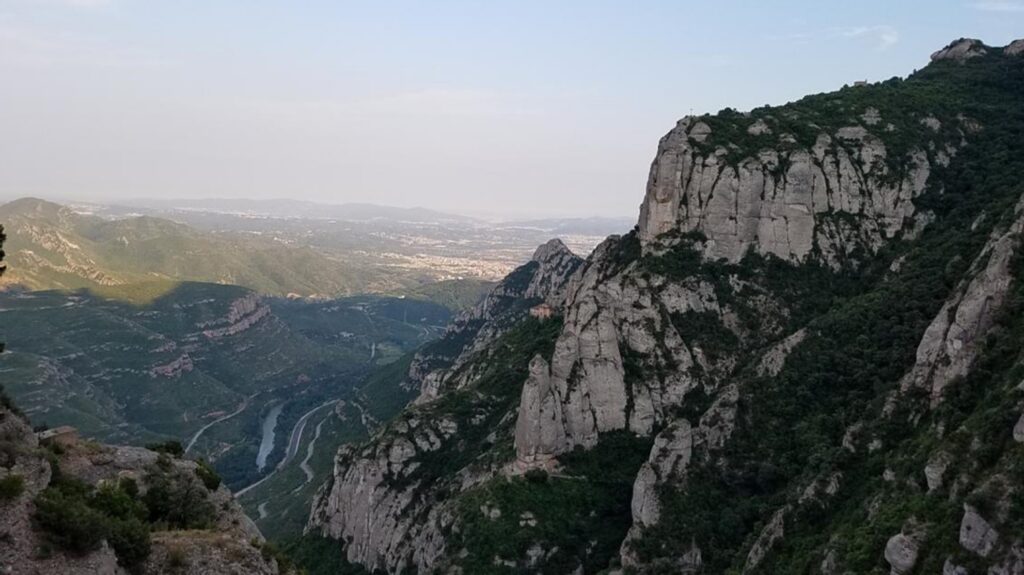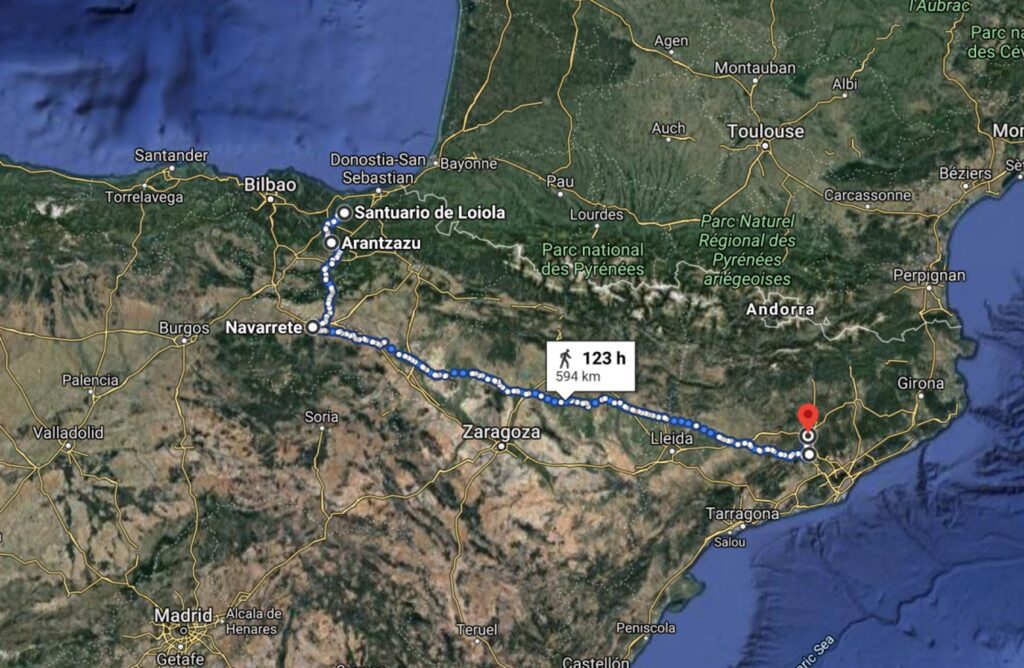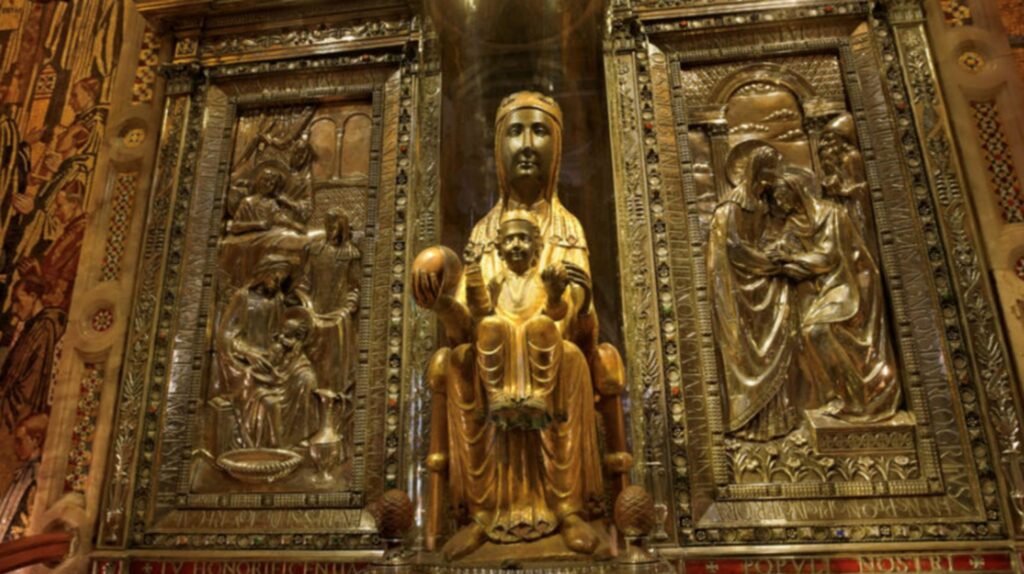
Chap. 4 A New Journey Begins: Manresa
Martín was right to be suspicious. Ignatius didn’t plan on staying in Najera for long, but he wasn’t sure how to slip past the men traveling with him. He was still limping heavily, so he’d have to ride a mule for most of the way. Perhaps he could escape one night in Najera when no one was looking. In the meantime Ignatius dressed in his finest clothes and brought his knight’s sword and dagger with him. He had to look the part even if he didn’t intend to keep these things much longer.
The three men traveling with him were his brother Pedro and two household servants from Loyola. Ignatius was never close to his brother Pedro, although both of them loved getting into mischief in their younger days. When Ignatius was arrested during Mardi Gras of 1515, his brother Pedro was right alongside him, committing the same crimes. Now they were both grown men, but their lives were headed in different directions. While Ignatius was recovering from his battle wounds at Loyola and reflecting on God and the saints, Pedro was busy chasing after women and living recklessly, and he ended up conceiving a child out of wedlock. It’s not clear if Ignatius reprimanded his brother for this immature behavior, but having Pedro next to him on this journey must have been awkward. His brother represented the very lifestyle he was trying to leave behind, and his presence must have reminded Ignatius of all his past sins. They probably spoke little to each other on this trip.
Pedro only accompanied him for part of the way. The two servants kept traveling with Ignatius, and they finally arrived in Navarette, where Ignatius’s former boss was happy to see him. Now that he was a duke he could help Ignatius find a new position and get back to living in luxurious palaces and spending life with the elite of Spanish society. He owned quite a bit of land, and he offered to put Ignatius in charge of one of his properties, but Ignatius declined. The duke was surprised by Ignatius’s refusal, and their reunion was much shorter than the duke had expected. Ignatius was only passing through. It seemed he had other plans and only wanted to stay with the duke for a short while before moving on to something else. The duke was puzzled but happy to give him lodging for a few days.
He gave lodging to the servants as well, but it seemed they were no longer needed either. They would head back to Loyola, but before they went home Ignatius informed them that he wouldn’t be returning with them. An even more famous monastery was nearby, and Ignatius planned to go there to pray and think about his life. The servants knew that Ignatius had been praying a lot these days, so his decision wasn’t a complete surprise, and they left Ignatius there and went back to the home of Ignatius’s brother Martín. What they didn’t realize was how serious Ignatius was about pursuing this new way of life. Ignatius wouldn’t go back to Loyola or see anyone from his family for the next thirteen years.
Ignatius continued this part of the journey on his own, making his way to the east coast of Spain. Riding on a mule made the journey easier for him, but it was tough on his wounded leg, which swelled up at the end of each day. He was headed to a famous monastery called Montserrat where the monks were known for giving great spiritual advice. Ignatius was excited to pursue his new dreams here, but he was worried people wouldn’t take him seriously. Reports about him had spread to this part of Spain, and many people would recognize him as a knight who fought at Pamplona against the French. In their minds he’d always be a soldier, not a saint, and many of them probably heard about the mischief he gotten into when he was younger. Did he come to Montserrat to cause problems here as well?
Doubts began to swirl in his head as he traveled alone on the dirt road. Not only was he worried what others would think, but he also doubted his ability to see his plan through to the end. Did he have the inner strength to persevere with this new life, which would often be difficult? Strangers would see him and ask him about Loyola, fighting for Spain, and all the things he used to do in his former life. He’d recall the comfortable life back home and the luxurious lifestyle he had in Arévalo and Navarre. He’d constantly be tempted to go back to his old ways, especially when things got hard. Who would help him resist these temptations? Maybe this wasn’t such a good idea.

Ignatius was preoccupied with these thoughts when suddenly another traveler appeared on the road. The man was a Muslim. There had been Muslims living in Spain for centuries, although many Spaniards were prejudiced against them. When Ignatius was a boy, the king and queen of Spain tried to expel them from the country and confiscate all their property. At first Ignatius had no problem sharing the road with him and chatting for a while, but at one point they began talking about Mary, the mother of Jesus. The Muslim explained that he didn’t agree with the Church’s teachings about Mary’s virginity, and even though Ignatius tried to persuade him otherwise, the Muslim would not change his mind. Eventually the Muslim departed on a different route, and Ignatius kept thinking about their encounter, growing very upset each time he recalled their conversation. In his mind denying Mary’s virginity was a great dishonor, and the Muslim deserved to die for this! Clearly Ignatius had not changed as much as he thought, for he had not abandoned his earlier vices of acting rashly and resorting to violence. He paused for a minute and decided to put the matter in God’s hands. He let go of the reins to the mule, and if the mule headed in the direction of the Muslim, Ignatius would track him down and kill him. If the mule headed in the other direction, Ignatius would let the matter go and continue with his journey. Fortunately the mule headed in the direction toward the monastery.
Ignatius eventually calmed down and began to focus on Montserrat again. It took him a long time to get there, especially by mule. Altogether the distance between Loyola and Montserrat was over 400 miles, and much of it was uphill. Ignatius’s leg was still sore, and his foot needed bandaging, but the beauty of nature made the trip more worthwhile. The scenery was breathtaking, with rolling green hills much like those of his native town, and the skyline opened up into beautiful views of pasture all around. As Ignatius neared the coast the terrain became more level, but right before he reached his destination he could see a large mountain range bursting upward from the horizon, with multiple peaks pointing toward the heavens. The monastery was nestled inside these mountains. Even today visitors are struck by the grandeur of this isolated mountain chain surrounded by a sea of green countryside. It would take a while for Ignatius to make it up to the monastery, especially with his limp, but he must have been relieved to finally arrive.

He wasted no time after he got there. His first step was to renounce his former life and confess all his sins so that he could start over with a clean slate. Ignatius was deeply ashamed of his prior life, and he spent a long time writing all out all sins on paper to make sure he didn’t forget any. He next made his confession to one of the monks there, and he found a famous statue of Mary where he could pray for a while. This statue of Mary was several centuries old, and people would travel hundreds of miles to pray in front of it. You can still find the statue there today, and people gather in long lines just to see a glimpse of it.

Knights also had a custom of spending an entire night in prayer before such statues as they prepared to go off to war, and Ignatius decided to do the same this night but with a different purpose. Instead of praying for protection in battle, Ignatius prayed to become a better person, and he formally gave up his career as a knight by surrendering his sword and dagger before the statue. Instead of fighting physical wars for the King of Spain, he would fight spiritual wars for the King of Heaven.
The people who knew him would have been stunned that Ignatius gave up his sword, which was his most prized possession. He loved carrying it with him everywhere he went, and it was almost part of his identity. But Ignatius didn’t want anyone to know he was at Montserrat. This was about his conversion to a holier life, and no one needed to know about this except God. He wanted to make himself as unrecognizable as possible, so he donated his mule to the monastery, gave his expensive clothes to a poor man, and found an ugly, uncomfortable tunic to wear instead. He also let his hair and fingernails grow long, and he now looked like more like a street beggar than a nobleman from a wealthy family. He even started going by a different name now, asking that people not call him “Iñigo” anymore but “Ignatius.” He was trying to transform himself, and he didn’t want people to recognize the man he used to be.
Ignatius wasn’t successful in remaining anonymous. Word quickly spread that this famous knight was following in the footsteps of many saints from the past. Many would flock to come see him so they could say they had encountered a living saint. Ignatius didn’t want this attention, so he found a cave near the town of Manresa, and he spent hours every day there in prayer. Even though he confessed his sins, he was still haunted by them, and the darkness of the cave was a great metaphor for the darkness he felt in his life. The guilt was almost too much to bear, and he still had many doubts about becoming the kind of person God was calling him to be. Would he be good enough? How would he make it to Jerusalem on his own? Did he really confess all his sins, or were there others he forgot about? Despite moments of immense joy while he thought about God and spoke to Him from his heart, there were others where he fell into deep depression and even had thoughts of suicide.
The praying became too intense at times, so he came out of the cave periodically to interact with other human beings. Sometimes he traveled back up the mountain to the monastery to meet with the monk he confessed his sins to, and this monk would give him helpful advice to prevent Ignatius from going to extremes in his prayer, especially when it came to guilt. He also had spiritual conversations with people in the nearby town of Manresa, talking to them about God and life, and he went to mass regularly so that he could receive Jesus in the Eucharist. He also continued his old habit of gazing upon nature, and one day he had a flood of insight as he sat alongside the Cardoner River. Ignatius never told anyone what insights he got there specifically, but it was such a momentous experience that he said his mind had been transformed and everything became brand new.
Later in his life Ignatius would emphasize the importance of “finding God in all things,” and perhaps this idea came to him as he sat alongside the river. Ignatius believed that God was present to us not only in prayer or at church but in every aspect of our lives. We just have to look hard enough. Oftentimes we miss God in our lives because we’re too busy with work or school, and we don’t notice the subtle ways that God is speaking to us. We might find God’s presence in the beauty of a rainbow or a majestic mountain, but we might forget to notice God’s presence when we’re playing a game with our friends, cooking a meal, or helping someone get through a difficult time. God’s love for us is so great that He is there with us always, even if that love takes different forms depending on the situation. Our task is to be perceptive enough to see where and how God is present to us in a particular moment.
This may have been one of the discoveries Ignatius made that day, but whatever new understanding he acquired, it gave him the courage and enthusiasm to keep praying to God each day and not worry about the negative thoughts he had. Those didn’t come from God, so there was no point in dwelling on them. He went back to the cave on a daily basis, and his traveling back and forth was a little easier with the walking staff he used. He was making great progress in his prayer life, and he decided to write these ideas down in a notebook. The prayers and meditations he was doing were helping him tremendously, and one day they could help others too. Most of them were about how to reflect on one’s daily life, and many of them were how to use one’s imagination while reading stories in the bible. The goal was to grow closer to God, and if you could imagine yourself listening to Jesus and witnessing his deeds firsthand, you would grow to love him even more. These reflections would become the basis for the Spiritual Exercises that Ignatius wrote later. He called them “exercises” because they could make your soul stronger, just like physical exercises make your body stronger.
The most important of these exercises was called the Examen. In English it sounds a lot like an exam, but that’s not what it’s about. It refers to examining your day, looking for moments of God’s presence, and seeing how you were a good person (or not) that day. There are five easy steps. First, put away all distractions and calm your mind so that you’re not thinking about anything else. Try to be aware of God’s presence and think about God as you make this prayer. Second, think about all the god things in your life and the joys you’ve had so far today. Give thanks to God for all these blessings. Third, reflect on your day so far, and recall the things you’ve done and the people you’ve interacted with. This is the heart of the Examen, and you should spend the most time on this step. What were the highs and lows of my day? What kind of person have I been so far today? Did I do something wrong or hurt anyone in any way? Did I fail to do something good for someone who needed my help? Fourth, ask God for forgiveness for the times you have failed to be a good person today. Fifth, think about how you want to be a better person tomorrow, and express this to God as you conclude your prayer.
The Examen would become the cornerstone for Ignatius’s spirituality for the rest of his life. It helped him think more about his actions and about how God was at work in his life, and he encouraged everyone to do this prayer. Ignatius was delighted by these spiritual discoveries, but they were taking longer than he expected. He only planned to spend a few days at the monastery and then make his way to Jerusalem, but he ended up spending a year in Manresa and Montserrat. He really wanted to examine his life and see how he could become a better person. He also became more famous than he expected, especially since he was trying to get rid of his old identity and not draw attention to himself. Somehow people heard about the intense spiritual conversion Ignatius was going through, and several of them wanted to help. He wasn’t eating much and didn’t bathe regularly, and he got sick several times. So some people offered him a place to stay where he could sleep in a warm bed and get a home-cooked meal from time to time. One was a widow named Inés Pascual, who hosted him for three weeks. She didn’t have much but offered him a place to sleep and did his laundry for him. She also made him chicken soup when he got sick and found sturdy shoes and warm clothes he could wear in the winter, which was bitterly cold that year. Ignatius also told her about his plan to go to Jerusalem, and she arranged for him to stay in a small room in a house in Barcelona while he waited for a ship headed to the Holy Land.
Reflection Questions:
- Have I ever made a major change in my life and tried pursuing a different path?
- Was God present to me recently, but maybe in a way I didn’t notice?
- Go back to the description of The Examen prayer above, and spend 10-15 minutes praying through the five steps.
Click here for chapter 5
